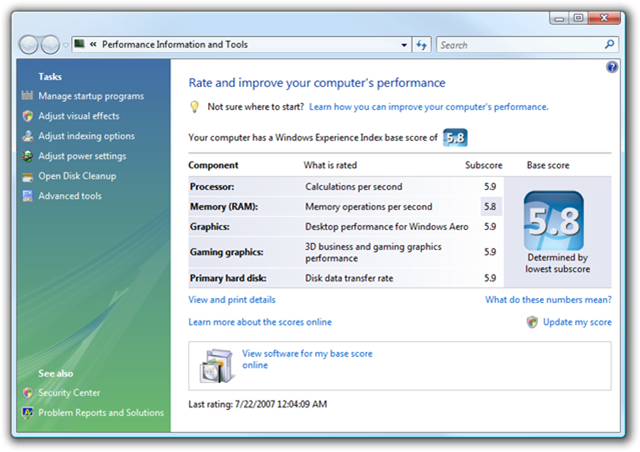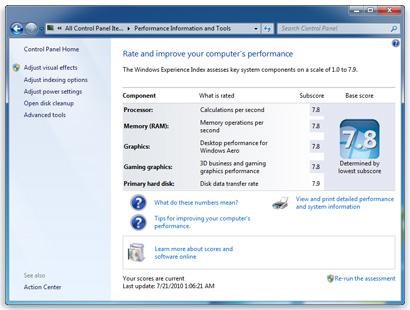-
-
products
-
resources
-
support
-
company
-
Understanding the Windows Experience Index
By Steve Horton April 19, 2013upgrading, windows, windows experience index2 CommentsThe Windows Experience Index is a score that Windows uses to determine how powerful your PC is, and how well it can handle all the features available in Windows.
Let’s say you have two different people: a young mother of two and a man with an incredible amount of money to spend on computers.
The mother buys a cheaper machine with balanced parts and gets a Windows Experience Index score of, say, 4.
The man buys an expensive machine with top-line everything- except for a graphics card, which he decides he’ll worry about later.
He gets a 3.
What happened?

See that “Determined by lowest subscore” text beneath the Base score? That’s important.A chain’s grade is determined by its weakest link, because one bad part of a chain can result in said chain breaking and anyone involved being incredibly frustrated and/or injured.
The Windows Experience Index operates under the same belief: that a computer is only as good as its weakest part. It doesn’t matter how expensive your other parts are or how much you spent on that memory, or that massive hard drive, or that hex-core processor: if you have a bad part in your computer, that’s the only part that the Windows Experience Index cares about.
Here’s what each of the grades actually mean:
- Processor: Calculations per second.
In simple terms, the speed of your processor- how fast your computer is. - Memory: Memory operations per second.
How much your computer can do simultaneously. The better your memory score, the more tabs and programs you can open at once. - Graphics: Desktop performance for Windows Aero.
In Windows Vista and 7, Windows Aero is what allows the “glass” transparent effect. - Gaming graphics: 3D business and gaming graphics performance.
Running games like Call of Duty or Crysis? This grade determines how good your graphics card is at that. - Primary hard disk: Disk data transfer rate.
How fast does your computer load when you turn it on? How long do on-disk movies, games and other files take to execute? This grade answers those questions.
With this knowledge in mind, does that mean the mother in the example above got a better computer for less money?
No, but she did get a balanced machine, which means that the parts are going to work adequately and one part isn’t going to bottleneck another.
Bottlenecking is when one component of a computer holds back the full capabilities of another. In that sense, the Windows Experience Index is useful — the objects with the lower subscores are bottlenecks to the ones with higher scores in most circumstances, and if you have just one bad part while everything’s rated insanely high, there’s your issue. Replacing that part — if you’re using a desktop PC — means a higher score and balanced performance for your machine.
If you find your computer works just fine for your needs, though, don’t worry about it.
You don’t need to spend a bunch of money to boost a bad score if what you have suffices. While most people would probably prefer you got that score balanced out, there’s no need to go out of your way if what you have already functions for doing what you need.
And if you ever do want something better, well…
You know what to upgrade.

There’s no need to waste money for a high score if you like what you have.Was this post helpful?YesNoFree Driver Updates
Update your drivers in less than 2 minutes to enjoy better PC performance - Free.
Free Driver Updates
Update your drivers in less than 2 minutes to enjoy better
PC performance - Free.
Didn't find your answer?Ask a question to our community of experts from around the world and receive an answer in no time at all.most relevant recent articles Pin It on Pinterest
- Processor: Calculations per second.